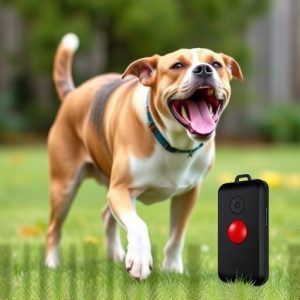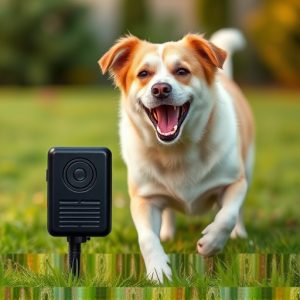Electronic Dog Deterrents: Customized Intensity for Safe Training
Aggressive dog behavior can be safely managed using customizable electronic bark control devices. Th…….
Aggressive dog behavior can be safely managed using customizable electronic bark control devices. These tools allow owners to tailor intensity settings for effective deterrence without causing harm, catering to diverse canine sensitivities. Correct sensor positioning and gradual intensity adjustments ensure accurate detection and humane training. Responsible use involves ethical practices, monitoring, positive reinforcement, and adhering to local laws, preventing overstimulation and fostering desired behavioral changes.
Aggressive dog behavior can be a significant concern, impacting both canine welfare and human safety. This article explores an electronic solution to deterring aggressive dogs, delving into the causes and effects of such behavior and how customizable bark control devices can play a crucial role in training. By understanding the intensity settings and proper adjustment techniques, pet owners can ensure effective results while adhering to safety considerations for responsible use.
- Understanding Aggressive Dog Behavior: Causes and Effects
- The Role of Electronic Deterrents in Dog Training
- Customization: Key to Effective Bark Control Intensity Settings
- How to Set and Adjust Bark Control Devices for Optimal Results
- Safety Considerations and Responsible Use of Aggressive Dog Deterrents
Understanding Aggressive Dog Behavior: Causes and Effects
Aggressive dog behavior can stem from various factors, and understanding these causes is crucial for implementing effective deterrent solutions. One of the primary triggers is fear or anxiety, where dogs may react aggressively to perceived threats in their environment. This could include unfamiliar people, animals, or loud noises. Traumatic experiences, such as past abuse or neglect, can also lead to aggressive responses as the dog associates certain stimuli with pain or danger. Additionally, breed characteristics and individual temperament play a role; some breeds are naturally more protective, while others may have a higher threshold for aggression.
The effects of aggressive behavior can range from minor incidents like barking and growling to more severe cases of biting and lunging. Uncontrolled aggression can cause fear in owners and passersby, impacting the dog’s quality of life and their ability to safely interact with others. Customizable bark control intensity settings offer a tailored approach to address this issue. By adjusting the sensitivity and response level, owners can ensure that the deterrent is effective without causing unnecessary stress or harm to the animal.
The Role of Electronic Deterrents in Dog Training
Electronic deterrents have become a popular tool in dog training, offering a modern approach to addressing behavioral issues, especially when it comes to managing excessive barking. These devices are designed to provide a safe and effective way to train dogs by utilizing specific sounds or vibrations to encourage desired behaviors. One of the key advantages is their ability to be customized, allowing owners to adjust the intensity settings according to their dog’s response and needs. This customization ensures that the training remains positive and gradual, avoiding any potential shock or discomfort that may arise from more aggressive methods.
By offering a range of sensitivity levels, electronic deterrents enable trainers to target specific behaviors, such as barking, without causing harm. Dog owners can gradually increase the intensity if their pet continues to display unwanted behavior, ensuring a tailored training experience. This flexibility is particularly beneficial for dogs with varying sensitivities and temperaments, allowing for a more personalized approach to their education.
Customization: Key to Effective Bark Control Intensity Settings
The effectiveness of an aggressive dog deterrent electronic solution lies in its ability to be customized, especially when it comes to Bark Control Intensity Settings. These settings allow for a tailored approach, addressing individual dog behavior and environmental factors. By adjusting the intensity level, users can ensure that the deterrent is responsive yet humane, only activating when necessary. This customization ensures that the device adapts to different scenarios, whether it’s a small, yippy dog or a larger breed with a more robust bark.
Each dog has its unique temperament, and what works for one might not work for another. Therefore, Customize Bark Control Intensity Settings are crucial in achieving optimal results. Through experimentation, owners can find the perfect balance—one that discourages excessive barking without causing distress to the animal. This precise control enhances the overall training process, fostering a more peaceful environment for both the dog and its surroundings.
How to Set and Adjust Bark Control Devices for Optimal Results
When setting up an electronic bark control device, customizing the bark intensity settings is key to achieving optimal results. These devices emit a high-frequency sound or static when a dog barks, designed to disrupt and deter excessive barking without causing harm. During installation, ensure the sensor is positioned correctly – usually at chest height – to detect barking accurately. Then, adjust the sensitivity level to match your dog’s barking habits. Start with a lower setting and increment it gradually until the device effectively stops unwanted barking. Regular testing and fine-tuning will help find the perfect balance.
Remember, consistency is crucial. Set the device to activate at specific triggers, like loud or persistent barking. You can also program different intensity levels for varying scenarios: lower for playful barks, higher for aggressive ones. This customization allows for tailored responses, ensuring your dog receives the appropriate correction while promoting good behavior.
Safety Considerations and Responsible Use of Aggressive Dog Deterrents
When considering an aggressive dog deterrent electronic solution, such as bark control devices, it’s paramount to prioritize safety and responsible use. These devices should be viewed as tools to manage canine behavior rather than harsh punishments. Always ensure they are used ethically and in accordance with local laws and regulations, which often have specific guidelines for the training and management of pets.
One critical aspect is customizing the bark control intensity settings. Many advanced systems allow for adjustable sensitivity levels and response intensities, ensuring that the correction is proportional to the dog’s behavior. This customization prevents over-stimulation or unnecessary stress on the animal while effectively teaching desired behavior changes. Responsible use includes regular monitoring, gradual acclimation of the pet to the device, and providing positive reinforcement for good behavior alongside any electronic deterrent.
In addressing aggressive dog behavior, electronic deterrents offer a modern solution that can be highly effective when used responsibly. By understanding the causes and effects of such behavior, as well as the role of these devices in training, pet owners can make informed decisions. Customizing bark control intensity settings is crucial for optimal results, ensuring both safety and effectiveness. With proper adjustment, these tools can help create a peaceful environment without causing harm. Remember, responsible use involves setting appropriate intensity levels and consistently reinforcing positive behavior, fostering a harmonious coexistence between pets and their owners.


